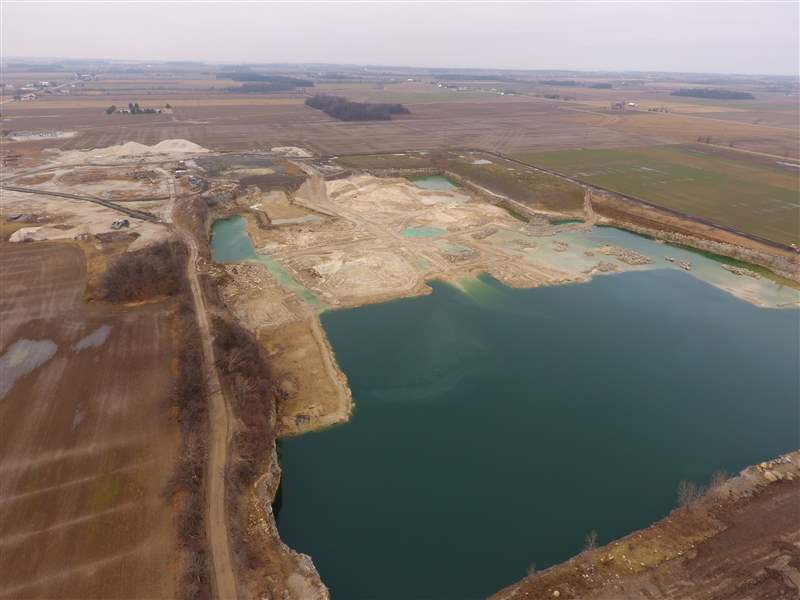
ROCKY RIDGE DEVELOPMENT
EPA sets 26 conditions on quarry project
Collins Park residue in mix
2/17/2017
Drone photos of the Rocky Ridge Development quarry.
GRAYTOWN, Ohio — The Ohio Environmental Protection Agency this week spelled out 26 ways it expects Rocky Ridge Development LLC to tighten monitoring, reporting, and operations at the company’s quarry in Ottawa County’s Benton Township, where the company is burying state-approved residue from Toledo’s Collins Park Water Treatment Plant.

The directives are in a new land application management plan, or LAMP, a document that modifies the permit for site operations the state agency issued to Stansley Industries, Inc., an affiliated company, on Nov. 13, 2014.
The Ohio EPA clarified its position that only waste generated by the Toledo water-treatment plant is to be used — a mixture of spent lime and trace amounts of other chemicals used to soften, disinfect, and otherwise treat drinking water the city produces for its nearly 500,000 metro area customers.
The blend that Rocky Ridge buries must be at least 65 percent soil, with no more than 35 percent drinking water treatment material, according to the permit.
In apparent response to concerns raised by Benton Township residents, the state agency also made clear Rocky Ridge is not yet authorized to place any of the material or do any of the blending in a sand or gravel pit, a limestone or sandstone quarry, an area with less than a 10-foot buffer from groundwater, or any area “that has been deemed to be highly susceptible to contamination.”
“Stansley or Rocky Ridge shall not cause pollution or place or cause to be placed any [water-treatment residue] blend in a location where it causes pollution to any waters of the state, except in accordance with an effective [U.S. EPA] permit,” one of the conditions states.
Another forbids contamination of wetlands and other federally protected waterways.
John Taddonio, Rocky Ridge Development manager, said the company has no problem with the 26 conditions and said they help clarify expectations.
The current permit, which expires at the end of 2019, authorizes the residue blend to be used only for general fill, improving drainage, and building berms, he said.
Later this year, Rocky Ridge expects to hear if it will be authorized to put the material into the quarry.
If so, the Benton Township site would become the state’s first quarry to be refilled with such material.
Rocky Ridge envisions that as a 10-year project that also would include a lot of planting to convert the site into wildlife habitat.
“We believe it’s very safe. The science supports that,” Mr. Taddonio said.
Opponents include dozens of area residents who question if any spent lime or chemical residue mixed into the soil could migrate down into the local aquifer or possibly out to Ottawa County’s nationally known Lake Erie marshes.
“It is our concern that the heavy metals that have bound to the lime will find its way into our private wells. We are fighting to have clean, safe water for our families, farm animals, and local wildlife,” one township resident, Angel Wadsworth, said.
For weeks, a citizens group has had drone photography taking aerial photographs.
“I don’t have any issues with that at all. I don’t object if they’re using their drones to peek and see what’s going on. I don’t fault the neighbors for having concerns,” Mr. Taddonio said. “The material has been tested and retested. It’s very stable, very consistent, and very safe. There’s really no scientific basis for thinking it’ll have an adverse effect on drinking water, because it won’t.”
He said the company has placed nothing inside the quarry yet.
Contact Tom Henry at: thenry@theblade.com, 419-724-6079, or via Twitter @ecowriterohio.